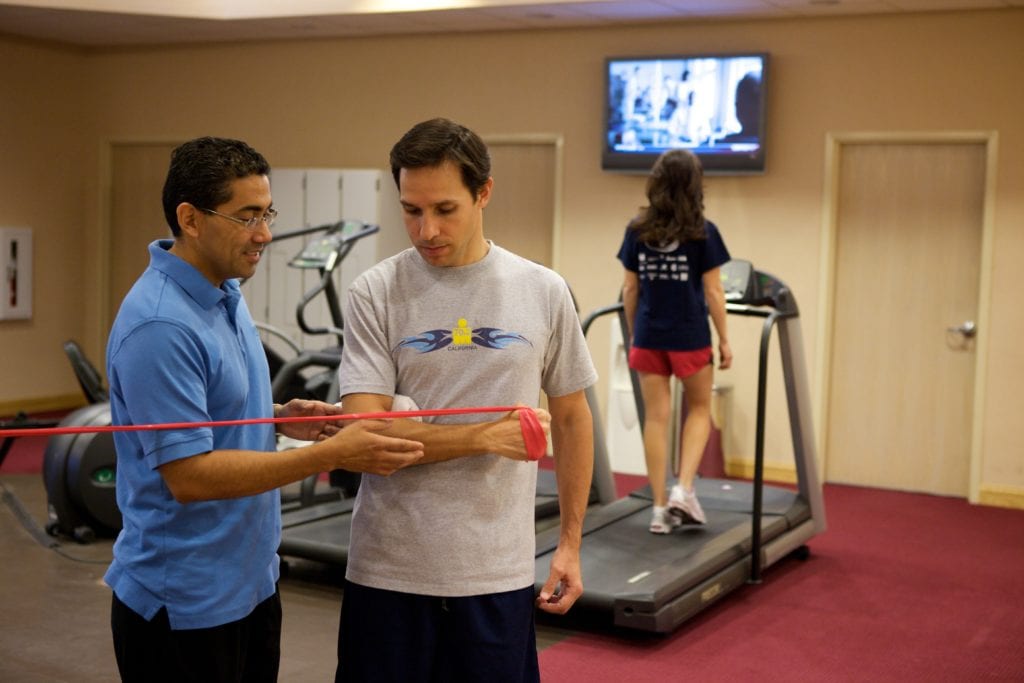Physical Therapy for Injuries

Postoperative Physical Therapy
After you go through an orthopaedic surgery procedure, it is essential to complete a physical therapy program. This allows the muscles and joints to heal properly, and reduces the chance of re-injuring the same afflicted area. Our on-site rehabilitation center is state-of-the-art and fully equipped with everything you need to get back on your feet fast.
Between physical therapy and therapeutic massage [link to massage page] for injury, strength and mobility return to previously injured body parts, and patients can get back to their regular lives in no time. Our skilled and caring rehabilitation specialists work strategically with patients to develop a customized therapy plan that promotes strong, pain-free, and healthy muscles and joints.
Benefits of physical therapy for injuries
Physical therapists can target deficiencies or weaknesses after an operation. They know what kind of physical limitations the body faces after surgery, and can guide patients through movements and procedures that restore and repair healing body parts.
From core-strengthening and stability movements to exercises that strengthen the body as a whole, physical therapy for injuries reinforces and elongates muscles to promote healing and prevent another injury from happening. Our rehabilitation specialists work with patients on stretching, as well as perform ultrasounds and electrical stimulation to heal the body after orthopedic surgery.
Types of physical therapy for postoperative recovery
Patients at our postoperative rehabilitation facility receive a personalized physical therapy plan. Some of the various types of physical therapy methods we utilize include:
Ultrasound: Ultrasound decreases pain and improves range of motion by transmitting high- or low-frequency sound waves to the surrounding tissue and blood vessels. Penetrating the muscles to create a warming sensation, ultrasound promotes relaxation of muscle tightness and spasms. It assists in healing and can decrease inflammation.
Cold pack therapy: Frozen-gel cold packs can treat pain and inflammation. We wrap a pack in wet towels and apply it to the area in pain. Cold temperatures constrict the blood vessels, decreasing inflammation, pain, and swelling.
Electrical stimulation (E-Stim): Our rehabilitation specialists place electrodes on the skin that send an electric current to a single muscle or group of muscles. The current causes the muscles to contract, which helps strengthen the affected muscle and promote the flow of blood to the area. The electric current can be adjusted based on the patient’s needs and comfort.
Exercise and stretching: Strengthening and stretching exercises targeted toward the specific area of need can promote healing and prevent another injury from occurring.
Massage: Manipulating the soft tissue and joints with massage is a beneficial physical therapy technique. Massage enhances function, promotes the body’s natural healing, lowers muscle-reflex reactions, induces relaxation, and elevates overall health.
Why physical therapy is an integral part of healing process
Without physical therapy, muscles would grow stiff and tight. The body part where you had surgery would not heal properly and would become highly susceptible to re-injury. We want our patients to feel strong and healthy after their surgery, which is why we design custom physical therapy care plans for every individual case.
Physical therapy for injury is a way to target areas with pain or discomfort. With the guidance of our professional rehabilitation team, you’ll have a successful surgery outcome and feel healthy and able-bodied for years to come.
AOI Advantages
We take care of you on-site, state certified Surgery Center. You don’t have to go to a hospital.
You will receive same-day service — walk in, walk out – no crutches, no overnight stays.
There is a comfortable waiting area for family & friends, complete with refreshments, snacks and DVD/ Satellite Entertainment Theatre.
We use minimally invasive surgical procedures that dramatically reduce your recovery time.
The same friendly, reliable staff is with you from consultation through rehabilitation.
There will be minimal scarring, with tiny entry points similar to the diameter of a pea.
You will benefit from thorough follow-up and physical rehabilitation services.

